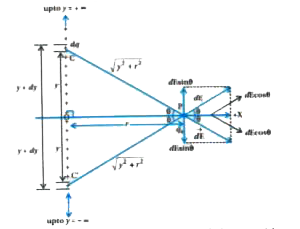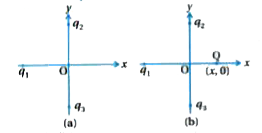Obtain the formula for the electric field due to a long thin wire of uniform linear charge density E without using Gauss's law. (Hint: Use Coulomb's law directly and evaluate the necessary integral.)

Solution in Gujrati
Consider infinitely extended line of charge with constant linear charge density . Let us determine its electric field at perpendicular distance r say at point P as shown in the figure. For this consider a charge element dq at distance y from central point O. Here,
Magnitude of Coulombian force exerted by above charge element dq on test charge placed at point P is,
........(1)
Magnitude of electric field of charge element dq at point P is,
.........(2)
Similary magnitude of electric field of charge element dq (selected on opposite side of central point O) at point P is also,
When we resolve above two electric fields into two mutually perpendicular components at point p we find that dEsinG components cancel each other (because of equal magnitudes and opposite directions). Hence, we get electric field at point P only due to components which are in same directions and so we can make their scalar addition to find resultant electric field E at point P Thus,
From eqn. (2) and from
...........(3)
In right angled
.......(4)
For a given point P value of r is constant and so from above equation,
........(5)
Now, (From equation (4))
.........(6)
From equation (4)
When
............(7)
From eqn (3), (5),(6) and (7),
Topper's Solved these Questions
- BOOK - KUMAR PRAKASHANCHAPTER - ELECTRIC CHARGES AND FIELDS EXERCISE - SECTION B NUMERICALS (NUMERICAL FOR .DARPAN. BASED ON TEXTBOOK)8videos
ELECTRIC CHARGES AND FIELDS
- BOOK - KUMAR PRAKASHANCHAPTER - ELECTRIC CHARGES AND FIELDS EXERCISE - SECTION C NCERT EXEMPLAR SOLUTION (MULTIPLE CHOICE QUESTIONS (MCQs))7videos
ELECTRIC CHARGES AND FIELDS
- BOOK - KUMAR PRAKASHANCHAPTER - ELECTRIC CHARGES AND FIELDS EXERCISE - SECTION B NUMERICALS (NUMERICAL FROM TEXTUAL EXERCISES)24videos
ELECTRIC CHARGES AND FIELDS
- BOOK - KUMAR PRAKASHANCHAPTER - DUAL NATURE OF RADIATION AND MATTEREXERCISE - Section-D (MCQs asked in GUJCET/Board Exam)1videos
DUAL NATURE OF RADIATION AND MATTER
- BOOK - KUMAR PRAKASHANCHAPTER - ELECTROMAGNETIC INDUCTIONEXERCISE - Section D MCQs (MCQs asked in Competitive Exams )38videos
ELECTROMAGNETIC INDUCTION
Similar Questions
Two spheres of copper, having mass 1 g each, are kept 1 m apart. The number of electrons in them are 1 % less than the number of protons. The electrical force between them is Atomic wt. of copper is 63.54 g/mol, atomic number is 29, Avogadro's number NA=6.023×1023mol−1 and k=9×109 SI
12:26View SolutionIn figure, two positive charges q2 and q3 fixed along the y-axis, exert a net electric force in the + x direction on a charge q1 fixed along the x-axis. If a positive charge Q is added at (x, 0), the force on q1
 12:26View Solution
12:26View SolutionWhat is the force between two small charged spheres having charges of 2×10−7C and 3×10−7 C placed 30 cm apart in air ?
04:01View SolutionMass of photon in motion is ………
04:10View SolutionThree pure inductance each of 3 H are connected as shown in figure. The equivalent inductance of this connection between points A and B is ......
 06:31View Solution
06:31View SolutionObtain the formula for the electric field due to a long thin wire of uniform linear charge density λ without using Gauss's law. [Hint. use Coulomb's law directly and evaluate the necessary integral].
View Solutionगाउसीन नियम का उपयोग किये बिना एकसमान रैखिक आवेश घनत्व λ के लंबे एटले तार के कारण विधुत क्षेत्र के लिए सूत्र प्राप्त कीजिये [ साकेत : सीधे ही कुलाम नियमका उपयोग करके आवश्यक समाकलन का मान निकालिये ]
09:43View SolutionState Gauss's law in electrostatics. Use this law to derive an expression for the electric field due to an infinitely long straight wire of linear charge density λcm−1
View Solutionगोस नियम का उपयोग किये बिना किसी एक्शमन रेखिक आवेश घनत्व λ के लम्बे पतले तार के कारण विधुत छेत्र के लिए सूत्र प्राप्त कीजिये संकेत शिंदे ही कलम नियम का उपयोग करके आवशयक समाकलन का मान निकालिये
06:02View Solutionगॉस के नियम द्वारा रेखीय आवेश के कारण विद्युत् क्षेत्र की तीव्रता ज्ञात कीजिए ।
07:39View SolutionObtain the formula for the electric field due to a long thin wire of uniform linear charge density λ without using Gauss's law.
View Solutionगाउस नियम का उपयोग किए बिना किइस एकसमान रैखिक आवेश घनत्व λ के लम्बे पतले तार के कारण विधुत क्षेत्र के लिए सूत्र प्राप्त कीजिए। [संकेत - सीधे ही कूलॉम नियम का उपयोग करके आवश्यक समाकलन का मान निकालिए ]।
View SolutionObtain the formula for the electric field due to a long thin wire of uniform linear charge density E without using gauss law
02:43View SolutionObtain the formula for the electric field due to a long thin wire of uniform linear charge density E without using gauss law
View SolutionObtain the formula for the electric field due to a long thin wire of uniform linear charge density λ without using Gauss's law. [Hint.use Coulomb's law directly and evaluate the necessary integral ].
02:34View Solution
